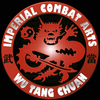SWORD STAVES
GLAIVES - FUCHARDS
杖刀
|
Sword-staves and Glaives are taught at Imperial Combat Arts as part of an advanced weapon study. The Glaive is a traditional pole-arm weapon that is essentially a sword blade on a long handle. These powerful weapons have been used the world about for ancient and medieval warfare. The Glaive or Fauchard is a European term for these weapons. There are several styles of Chinese Glaives taught at Imperial Combat Arts that each have unique designs to fit with our different fighting styles.
|
Chinese Swordsmanship at a historically accurate combat level is a very different study than the theatrical and acrobatic sword training seen in many modern Chinese martial arts schools. Our combat level sword training has direct lineage to the battlefield, and can hold its own with, or surpass any other weapon system in the world, and blends seamlessly with our hand to hand, ground systems, and chin na, as a complete study.
ASSAULT SWORD
|
CRESCENT MOON SABER
|
EYEBROW GLAIVE
|
HOOK & BLADE GLAIVE
|
DRAGON HEAD GLAIVE
|
PEN GLAIVE
|
PHOENIX BEAK GLAIVE
|
ELEPHANT NOSE GLAIVE
|
RAISED GLAIVE
|
EAR GLAIVE
|
3 POINT 2 BLADE GLAIVE
|
CICADA WING SWORD
|
TRAINING THE GLAIVE
The Glaive is taught at Imperial Combat Arts only after extensive study in both the Saber (Tao) and the Staff. The training and techniques of these two weapons combine together to form the sword-staff or Glaive. Some Glaives are fast light weapons and others are heavy weapons that require great size and strength to wield.
BENEFITS OF GLAIVE TRAINING
Glaive training strengthens the body for combat in a way that empty hand training and weightlifting cannot by using weight in a dynamic and combative way. Glaives trained at Imperial Combat Arts can vary in weight of 5lbs up to as much as 60lbs for large an powerful people. It is not uncommon for people today to doubt if weapons of such weight can be used in combat. In reality warriors of great strength have used tremendous weapons that most average men could not. Still today there are men who demonstrate the use of bows with 185lb draw weight, and other feats of great weapon strength.
GLAIVE DRILLS
Glaive drills are an important part of training sword-staves. These drills teach primary grips, stances, maneuvers, cuts, chops, slashes, blocks, parries, and thrusts, and build these important movements into the body as a second nature reflex. Weapon drills are done in the air, vs partners, dummies, and all types of specialized equipment. The intricate artwork painted on the floor of the school at Imperial Combat Arts is designed for students to drill attacks and defenses against multiple opponents in all 8 directions.
GLAIVE FORMS
Glaive forms are one of the primary ways Masters pass on the ancient knowledge of sword-staves to the next generation of Warriors. These challenging forms teach dynamic flow, maneuvers, weapon handling, and numerous proven and effective techniques. Every movement and technique in the weapon forms at Imperial Combat Arts relate directly to combat, and are trained dynamically in sets, and matching. Forms are a way to practice your techniques routinely, and turn them to muscle memory, as needed for battle.
GLAIVE SETS
Dynamic sets allow students to learn effective techniques and Glaive applications that could never be used in sparring. Even with full pads a training Glaive can cause serious injury or death, therefore mastering Glaive requires a skilled and dedicated partner with focus and control. This repetitive partner interaction is one of the ways proven techniques are taught. At Imperial Combat Arts weapon sets are done vs multiple opponents, with realistic training weapons, as well as with padded weapons.
GLAIVE TARGETS
Throughout history target practice has been a crucial part of weapon development, as it still is today. In all parts of the world Straw Men, and Wooden Pell's of various types, have been the primary targets used to practice attacks and maneuvers. Imperial Combat Arts indoor/outdoor school has a full array of traditional and modern training dummies, accuracy rings, cutting posts, and dynamically moving targets designed specifically for Glaive training, as well as ranged targets for thrown bladed weapons.
GLAIVE MATCHING
Aggressive matching with training weapons is an important part of preparing for the chaos and fray of battle. This matching is also done in unusual and compromised ways, such as blindfolded, or on beams and posts. Most all matching done at our school, whether armed or unarmed, is done versus multiple opponents. These intense matching sessions are designed to be painful, yet safe, and push practitioners ever forward in skill. Aggressive pole-arm matching can only be done safely with padded weapons and armor.
GLAIVE VS OTHER WEAPONS
Aside from Glaive vs Glaive, there are numerous traditional sets to teach sword-staff interaction with other weapons. Some of these pairings are legendary such as Glaive vs Sword, Glaive vs Spear, Glaive vs Axe, and unarmed vs Glaive. Additionally learning how to use long weapons is an important part of melee weapon mastery. These important concepts and lessons transfer directly to empty hand tactics, such as fighting opponents with superior reach.



















